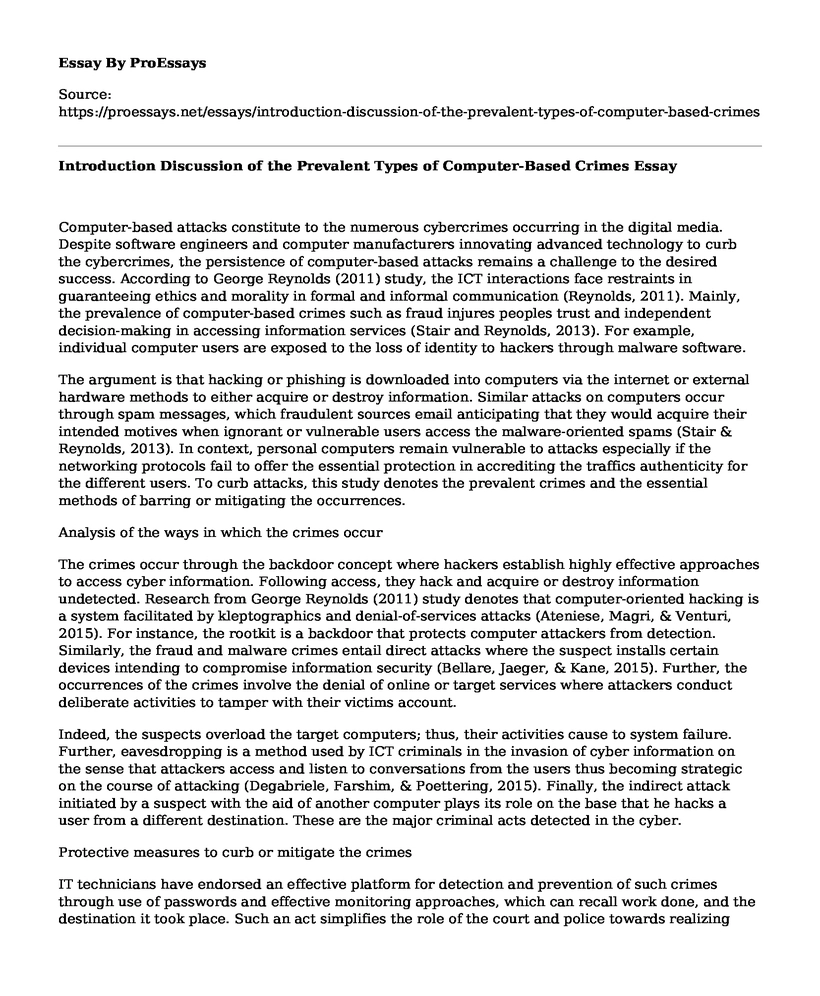Computer-based attacks constitute to the numerous cybercrimes occurring in the digital media. Despite software engineers and computer manufacturers innovating advanced technology to curb the cybercrimes, the persistence of computer-based attacks remains a challenge to the desired success. According to George Reynolds (2011) study, the ICT interactions face restraints in guaranteeing ethics and morality in formal and informal communication (Reynolds, 2011). Mainly, the prevalence of computer-based crimes such as fraud injures peoples trust and independent decision-making in accessing information services (Stair and Reynolds, 2013). For example, individual computer users are exposed to the loss of identity to hackers through malware software.
The argument is that hacking or phishing is downloaded into computers via the internet or external hardware methods to either acquire or destroy information. Similar attacks on computers occur through spam messages, which fraudulent sources email anticipating that they would acquire their intended motives when ignorant or vulnerable users access the malware-oriented spams (Stair & Reynolds, 2013). In context, personal computers remain vulnerable to attacks especially if the networking protocols fail to offer the essential protection in accrediting the traffics authenticity for the different users. To curb attacks, this study denotes the prevalent crimes and the essential methods of barring or mitigating the occurrences.
Analysis of the ways in which the crimes occur
The crimes occur through the backdoor concept where hackers establish highly effective approaches to access cyber information. Following access, they hack and acquire or destroy information undetected. Research from George Reynolds (2011) study denotes that computer-oriented hacking is a system facilitated by kleptographics and denial-of-services attacks (Ateniese, Magri, & Venturi, 2015). For instance, the rootkit is a backdoor that protects computer attackers from detection. Similarly, the fraud and malware crimes entail direct attacks where the suspect installs certain devices intending to compromise information security (Bellare, Jaeger, & Kane, 2015). Further, the occurrences of the crimes involve the denial of online or target services where attackers conduct deliberate activities to tamper with their victims account.
Indeed, the suspects overload the target computers; thus, their activities cause to system failure. Further, eavesdropping is a method used by ICT criminals in the invasion of cyber information on the sense that attackers access and listen to conversations from the users thus becoming strategic on the course of attacking (Degabriele, Farshim, & Poettering, 2015). Finally, the indirect attack initiated by a suspect with the aid of another computer plays its role on the base that he hacks a user from a different destination. These are the major criminal acts detected in the cyber.
Protective measures to curb or mitigate the crimes
IT technicians have endorsed an effective platform for detection and prevention of such crimes through use of passwords and effective monitoring approaches, which can recall work done, and the destination it took place. Such an act simplifies the role of the court and police towards realizing criminals involved in the heinous acts in the cyber. For instance, computer software is a critical part where protection has been enhanced through certain responses, for example, the use of Anti-virus and firewall. Critically attackers from different destinations use virus to influence networks and data from certain computers hence this curbs the situation. On the aspect of hardware firewalls, it prevents external attacks. In computer software, firewall plays a critical role in protecting the data and is quite difficult to configure. Such cyber security approach is intended at protecting internal users from `both the internal and external attacks. Research asserts that the firewalls are more powerful in protecting these parts, which facilitate access to information (Mann & Roberts, 2016).
References
Ateniese, G., Magri, B., & Venturi, D. (2015). Subversion-Resilient Signatures: Definitions, Constructions and Applications.
Bellare, M., Jaeger, J., & Kane, D. (2015). Mass-surveillance without the state: Strongly undetectable algorithm-substitution attacks. In Proceedings of the 22nd ACM SIGSAC Conference on Computer and Communications Security (pp. 1431-1440). ACM.
Degabriele, J. P., Farshim, P., & Poettering, B. (2015). A more cautious approach to security against mass surveillance. In Fast Software Encryption (pp. 579-598). Springer Berlin Heidelberg.
Mann, R., & Roberts, B. (2016). Business law and the regulation of business. Nelson Education.
Reynolds, G. (2011). Ethics in information technology. Cengage learning.
Stair, R., & Reynolds, G. (2013). Fundamentals of information systems. Cengage Learning.
Stair, R., & Reynolds, G. (2013). Principles of information systems. Cengage Learning.
Cite this page
Introduction Discussion of the Prevalent Types of Computer-Based Crimes. (2021, Mar 12). Retrieved from https://proessays.net/essays/introduction-discussion-of-the-prevalent-types-of-computer-based-crimes
If you are the original author of this essay and no longer wish to have it published on the ProEssays website, please click below to request its removal:
- Analysis of Juvenile Vandalism Article
- Research Paper Example on Internet
- Essay Sample on Cyber Terrorism and Information Warfare
- Psychological Study of Prisons and Prisoners
- Essay Examples on Gun Laws: A Global Human Rights Crisis
- Configuring DHCP Server on Windows Server 2016: Step-by-Step Guide - Report Sample
- Addiction - Research Paper Example







